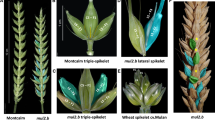Summary
The inheritance of supernumerary spikelets was found to be controlled by two recessive genes with evidence for the possibility of a repressor(s) in crosses between normal and supernumerary spikelet wheats.
In experimental lines with phenotypically normal heads but possessing the recessive supernumerary spikelet gene(s), increases in the number of nodes on the rachis (and hence the number of normal spikelets) fertility and grain number per head were found, as well as in the ‘normal’ Australian and American wheat cultivar Phoenix. This attribute has previously been suggested to be a way of increasing spikelet number in future wheat breeding.
Similar content being viewed by others
References
Kushnir, U. & G. M. Halloran, 1982. Cytology and fertility of pentaploid wheat hybrids with induced pairing between homoeologous chromosomes. Can. J. Gen. & Cytol. 24: 397–408.
Koric, S., 1973. Branching genes in Triticum aestivum. Proc. 4th Int. Wheat Genet. Symp. Columbia, Missouri. 283: 288.
Koric, S. 1978. Triticum aestivum ramifera, new genetic resource. Proc. 5th Int. Wheat Genet. Symp. New Dehli, India, 171–176.
Koric, S. 1980. Study of branched gene complex of Triticum aestivum ssp. vulgare and its significance for wheat breeding. Journal for Scientific Agric. Res. (Zagreb, Yugoslavia). 41 nos. 142: 271–282.
Pennell, A. L. & G. M. Halloran, 1983a. Influence of vernalization and photoperiod on supernumerary spikelet development in wheat. In preparation.
Pennell, A. L. & G. M. Halloran, 1983b. Influence of time of sowing, temperature and photoperiod on supernumerary spikelet development in wheat. In preparation.
Pennell, A. L. & G. M. Halloran, 1983c. Effect of nitrogen nutrition on supernumerary spikelet development in wheat. In preparation.
Percival, J., 1921. The wheat plant: A monograph. Duckworth & Co. London.
Rawson, H. M. & K. N. Ruwali, 1972a. Branched ears in wheat and yield determination. Aust. J. Agric. Res. 23: 541–549.
Rawson, H. M. & K. N. Ruwali, 1972b. Ear branching as a means of increasing grain uniformity in wheat. Aust. J. Agric. Res. 23: 551–559.
Salunke, M. R. & R. D. Asana, 1971. Comparative study of the development of grain in normal and branched ear types of wheat (Triticum aestivum L.) Indian J. Agric. Sc. 41(12): 1050–1053.
Sharman, B. C., 1967. Interpretation of the morphology of various naturally occurring abnormalities of the inflorescence of wheat (Triticum spp.). Can. J. of Bot. 45: 2073–2080.
Swaminathan, M. S., V. L. Chopra & G. R. K. Sastry, 1966. Expression and stability of an induced mutation for ear branching in bread wheat. Curr. Sci. 35: 91–92.
Tschermak, E. Von, 1914. Uber die Vererbungsweise von Art und Gattungsbastarde innerhalb der Getreidegruppe. Mitteil. der landw. Lehrkanzeln der KK Hochschule für Bodenkultur in Wien Bd. (ii) Heft.
Author information
Authors and Affiliations
Rights and permissions
About this article
Cite this article
Pennell, A.L., Halloran, G.M. Inheritance of supernumerary spikelets in wheat. Euphytica 32, 767–776 (1983). https://doi.org/10.1007/BF00042157
Received:
Issue Date:
DOI: https://doi.org/10.1007/BF00042157




